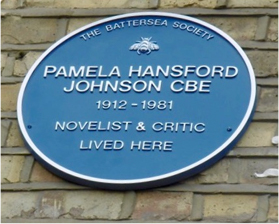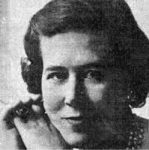A talk given by Zoë Fairbairns on May 19 2019 to mark the unveiling of a Battersea Society plaque in tribute to the local 20th century writer.

It was lovely to arrive on the train at Clapham Junction station earlier this afternoon.
‘Lovely’ and ‘Clapham Junction Station’ are not words that I would have expected in my early years to hear myself uttering in the same sentence. In the aftermath of World War Two, I saw Clapham, Battersea and surrounding areas as blitzed, dangerous and desolate.
By the time I discovered Pamela Hansford Johnson’s writings, large areas of the worst damage had been repaired and restored. But for me, the ghosts of the bombing still lingered.
Another subject that worried me in my early teens was sex. The permissive society had not yet reached my home suburb of Teddington, but there were rumours.
I didn’t know what to make of them. To me, the whole business sounded improbable, risky and undignified, yet strangely alluring. And I was intrigued to discover, when reading Pamela Hansford Johnson’s first novel This Bed Thy Centre in the 1960s, that girls in the 1930s had felt the same.
Another surprise was that the area had so recently enjoyed the qualities of a rural idyll. Clapham Common in the 1930s, Pamela tells us in her memoir Important To Me, consisted of ‘vast fields above which the stars were clear.’ It was a place where ‘sheep might safely graze’, and where ‘red-sailed cargo boats could be seen from the street, gliding with their wares up and down the river’.
It was also a place for courting couples. When Elsie Cotton, teenage protagonist of This Bed Thy Centre goes on her first date with boyfriend Roly, we learn that ‘the evening was quiet, and so delicate that a single word might ‘break it in two pieces. There was a watery light on the church spire, far away over the trees, and the lamps were lit on the path to the railway station.’
You don’t get that sort of peace and quiet on Clapham Common these days. Traffic thunders through on the South Circular, and the Common’s determination to be all things to all people (with its ponds and playgrounds, bandstand and bowling green, cafes and cricket nets, all-weather pitch and athletics sprint track) keeps the casual walker, not to mention the courting couples, in a state of constant alertness. A moment’s inattention and you could be mown down by someone more purposeful.
We can’t know whether a present-day young woman like Elsie Cotton, sexually inexperienced and not sure that she doesn’t want to keep it that way, would turn to Clapham Common for comfort and certainty. But Elsie does. This is from page 253 of the Five Leaves edition of This Bed Thy Centre.
‘With the darkening of the sap in the leaves, so Elsie’s heart darkened. Day by day, her fear mounted in her… Perfect love casteth out fear, she thought, as she walked through the little hills to sit alone by the pond. When we have loved each other for the first time, everything will change and I shall we able to feel myself alive again.
The surface of the pond bloomed with coming summer. Anyhow, I am not going away from all this. It will be here, near me, all the time. I am going to Roland whom I love, whom I must love, and not to a stranger. I am not going into a strange house. We shall lie together as we lay under the trees last year, only we shall not lie as we lay then.
Oh God, I don’t want to get married.’
To find out whether she does or not, read the book.
You’ll find a strong sense of place, and the place is here. Battersea and Clapham. Familiar and yet different.
Local churches, which in Pamela’s day were formal and choral and sacramental, now offer Alpha courses, play groups and debt counselling. There’s no Waitrose, no M & S, no Waterstone’s. Instead, shops in This Bed Thy Centre’s fictional Neighbourhood, include a draper’s, a hairdresser’s offering ‘perms for one guinea’, a cafe where you can enjoy ‘a hearty meal of kidneys on toast’, and even a Woolworth’s. (Remember Woolworth’s?)
And there’s a newsagent’s where, for those in the know, a copy of Lady Chatterley’s Lover is available for hire at sixpence per day, disguised as Robinson Crusoe.
This Bed Thy Centre, got a frosty reception in some parts of Pamela’s home area: it was banned from Battersea Rise public library, anonymous abusive note were shoved through 23-year-old Pamela’s letterbox, and some relatives refused to speak to her.
Some reviewers were just as harsh. Richard Church wrote in John O’London’s Weekly on April 20 1935, that the book was set in
a world of drunken and lewd suburbia, filling the reader with nausea, and speculation as to whether the Hour of Sanitation will come and flow over and obliterate the squalor in scenes of pubs and back streets and the minds of pimply adolescent girls.
So that was Clapham Common put in its place. But it has survived to become the sought-after suburb it is now, and the book which aroused Mr Church’s prissy disapproval, is still in print more than 80 years later.
Pamela went on to publish 27 other novels, as well as journalism, short stories, autobiography and criticism. We are here this afternoon to honour these, in the building where Pamela was born and lived much of her childhood – 51 Battersea Rise, now the Farrago Restaurant.
And we ourselves are honoured too, whether we live in the area or are accepting, as I am, your kind invitation to visit, by the presence of this fine author in the area’s literary history, and the continued availability and rich variety of her work.

